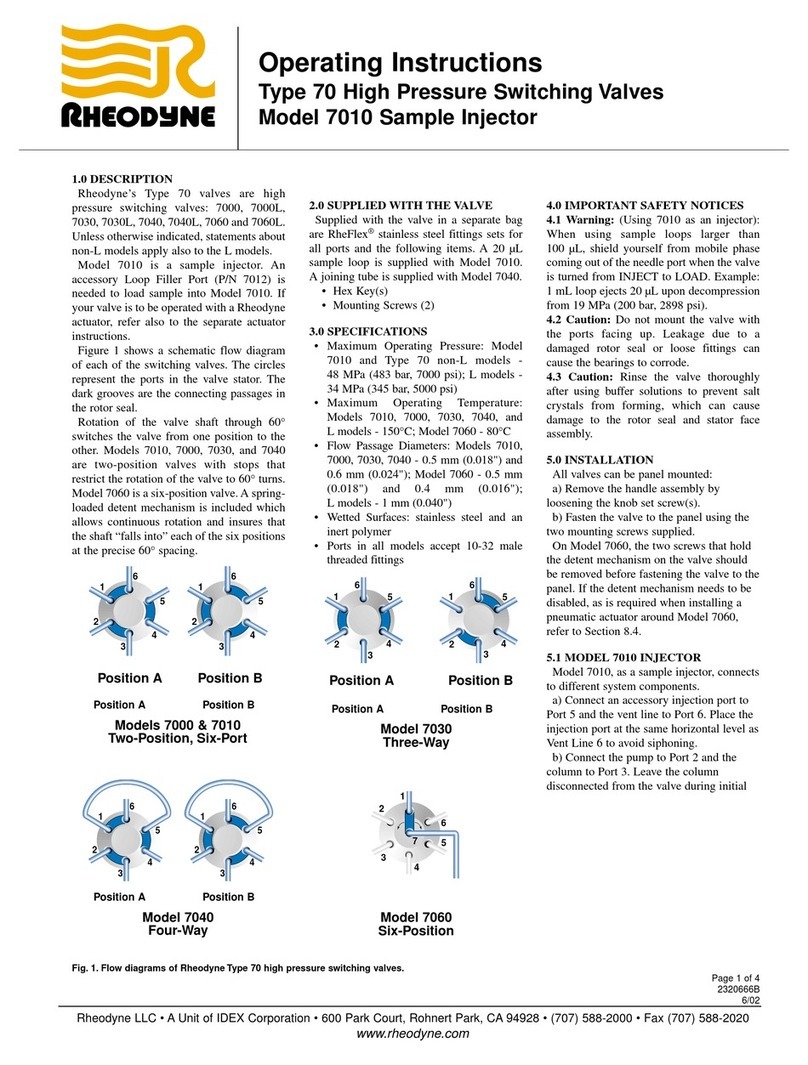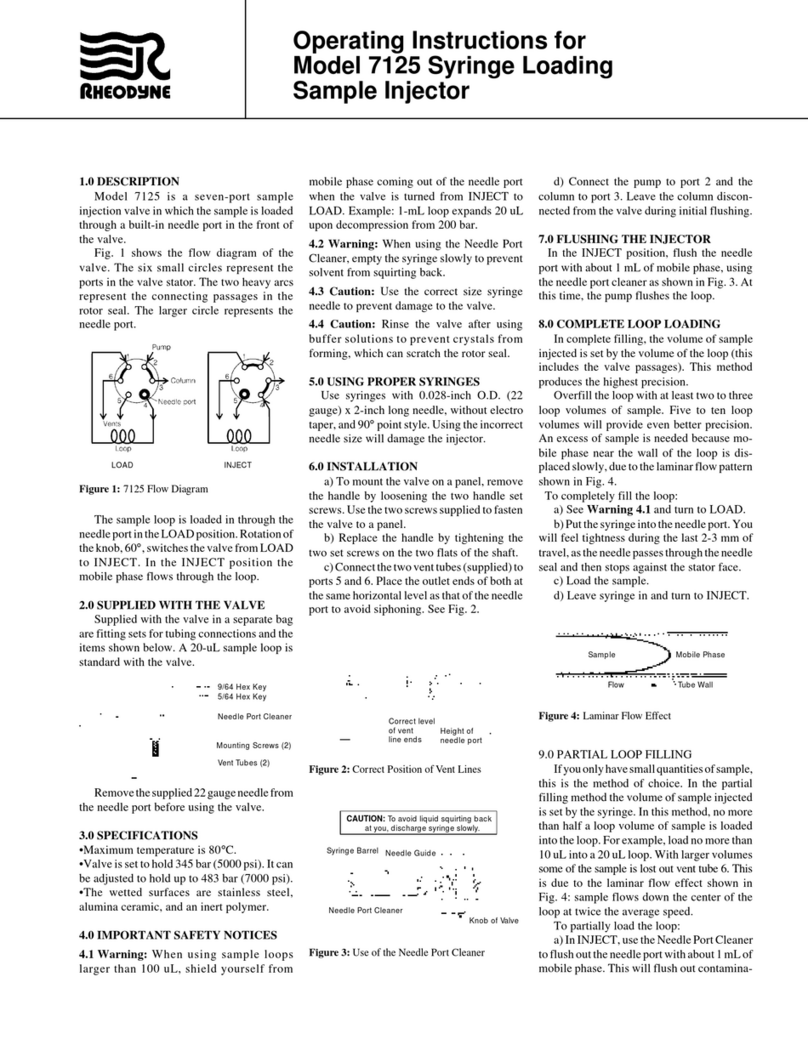d) Remove the two hex screws in the stator
ring. To make it easier to pull the stator ring
off, screw the two hex screws into two of the
three stator screw holes. Take the stator ring
off by pulling on the two hex screws while
rocking the stator ring back and forth (see
Figure 13). Pull the rotor seal off the four
pins.
Note: If the shaft assembly comes out with
the stator ring, ensure that the gear goes back
into the actuator body and lines up correctly
with the two racks on either side. The racks
can be moved up and down to align the
punch marks on the racks with the punch
marks on the gear (see Figure 14).
e) Remove the isolation seal (it may have
come off with the stator ring).
9.2.2 REASSEMBLY
To reassemble Model 8126, refer to Figures
11, 12, 13, and 14 and proceed as follows:
a) Mount the new isolation seal with the
open side facing the handle.
b) Line up the new rotor seal as shown in
Figure 11. The rotor seal grooves face the
stator. The notch on the rotor seal's metal
band is at 12 o'clock.
c) Replace the stator ring so that the two
pins in the stator ring enter the mating holes
in the actuator body. The two drain slots on
the stator ring must be in the down position.
Replace the two hex screws in the stator ring.
d) Follow steps d-g from Section 9.1.2.
9.3 POSITION SENSING SWITCH IN
MODEL 8125
The position sensing switch is standard in
Model 8125. The switch is a magnetic reed
switch actuated by a magnet sealed inside the
shaft. The switch is rated for 100 V at 200
mA.
To replace or remove the switch:
a) Remove the handle assembly.
b) Remove the three stator screws.
c) Remove the stator, stator ring, and stop
ring.
d) Pull the switch out of the stop ring.
e) Replace with new switch, or leave the
hole empty if the switch is not needed.
f) Follow the steps in Section 9.1.2 to
reassemble.
10.0 OPERATING SUGGESTIONS AND
TROUBLESHOOTING
10.1 LEAKAGE
If you see liquid between the stator and
stator ring, or from the needle port or a vent
tube, tighten the pressure adjusting screw as
explained in Section 8.0. If this fails to stop
the leak then replace the rotor seal and/or
stator face assembly.
10.2 NEEDLE SEAL LEAKAGE
Since the outside diameter of syringe
needles can vary, the needle seal (Teflon1
sleeve in the rotor seal) may not seal
correctly around a needle that is smaller than
average. This will result in the loss of
accuracy in loading the sample. To make a
good seal, remove the needle from the needle
port and push in on the plastic needle guide
with the eraser end of a pencil. Repeat if
necessary.
10.3 USE OF AQUEOUS BUFFERS OR
SALT SOLUTIONS
To prevent the formation of salt crystals in
the valve which can scratch the rotor seal,
flush out the flow passages and the needle
port with water after using salt solutions.
10.4 USE OF HIGH pH SOLUTIONS
The standard rotor seal in Models 8125 and
8126 is Vespel1, a polyimide with good wear
resistance. Vespel is sensitive to alkaline
attack when exposed to solutions having a
pH of 10 or more. Use a PEEK or Tefzel1
rotor seal for alkaline solutions.
10.5 ACCURACY OF SAMPLE LOOPS
Sample loop sizes are not actual values.
Actual volumes can differ by ± 10% for a 20
µL loop. Smaller loops show greater
differences. For actual injection volume, use
the partial-filling manual sample loading
method.
11.0 RECOMMENDED SPARE PARTS
Rheodyne offers a RheBuild™ Kit for
maintaining the quality performance of your
valve. The kit includes all the necessary
parts, tools, and instructions.
8125-999 RheBuild Kit for 8125 and 8126
12.0 WARRANTY
All Rheodyne products are warranted
against defects in materials and
workmanship for a period of one year
following the date of shipment by Rheodyne.
Rheodyne will repair or replace any
Rheodyne product that fails during the
warranty period due to a defect in materials
or workmanship at no charge to the
customer. The product must be returned to
Rheodyne’s factory in original packaging or
equivalent, transportation prepaid. Damage
occurring in transit is not covered by the
warranty. This limited warranty is
Rheodyne’s sole warranty of its products,
and all other warranties of merchantability or
fitness for any particular purpose are hereby
disclaimed. Under no circumstances will
Rheodyne be liable for any consequential or
incidental damages attributable to a claimed
failure of a Rheodyne product, even if
Rheodyne has been placed on notice of
possibility of such damages.
Fig. 13. Removing the stator ring with two hex
screws.
Set Screws (2)
Needle Guide
Handle Assembly
Shaft Assembly*
* Shaft Assembly includes Rotor, Shaft, and Pins.
Seal Pins (4)
Needle Port Tube
Rotor Seal
Stator Face Assembly
Drain Slots
Stator Ring
Stator Stator Screws
Isolation SealNotch
Fig. 12. Exploded view of Model 8126.
Page 4 of 4
2320667A
9/99
1Vespel, Tefzel, and Teflon are trademarks of E.I. DuPont.
Fig. 14. Alignment of punch marks.
Four Punch Marks
in Line
Correct Meshing of Gear
and Rack Teeth
Rheodyne LLC • A Unit of IDEX Corporation • 600 Park Court, Rohnert Park, CA 94928 • (707) 588-2000 • Fax (707) 588-2020
www.rheodyne.com























